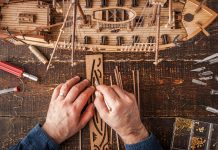6 Tips for Quality Scale Modelling
1. A True Master Masters the Basics: Start Simple and Build from There
Beginning any new venture can be daunting, but if you’re reading this post you’ve at least taken the first step towards an enjoyable and engaging hobby.
If this is your first time, choose a reasonably simple kit in your chosen field and just build it. Straight from the box, no paint, just concentrate on getting a great fit of parts, filling any gaps, and restoring lost panel lines etc. This builds knowledge and confidence, two tools that any scale modeller should carry at all times.
Don’t limit yourself to a specific medium either (e.g. wood, plastic, resin, latex, etc.). As each medium has its own quirks and pitfalls, you’d be surprised at how similar the solution is to a problem across all mediums.
2. Arm Yourself for Battle: Essential Tools for your Model Builds
Every model builder needs a toolbox, but what exactly should you fill it with?
Below is a list of necessities:
- A sharp hobby knife, with some old ones for scraping away mould lines
- Good paint brushes, with old ones for dry brushing
- A good set of clamps (clothes pegs, tweezers, bulldog clips etc.)
- Paints of all kinds and mediums (enamels, acrylics, pastels, and oils)
- Tape (scotch clear, electrical, and masking)
- Glues (plastic, super, and epoxy)
You can add specialised tools like saws, drills, and various other things, but with these basics you can still build a good model. After you build for a while you’ll collect all kinds of things like bottle caps (for mixing paint in), toothpicks, and even twist ties from bread bags. Find what works for you, and mould your kit to suit.
Source: http://forum.model-space.co.uk/default.aspx?g=posts&t=13415 (User: LrdSatyr8)
3. Innovate and Create: Using Household Items to Problem Solve
While model building can become an expensive exercise once you become truly immersed, there are many cheap household items that can be used to save you money and time.
Materials:
- Johnsons’ Future (US) / Klear (UK) – can be used as a hardwearing and durable gloss surface. Caution: this is very difficult to remove once dry, so clean brushes and airbrush thoroughly after use.
- Paper Towels – multi-purpose, use better quality towels to avoid fibre shedding.
- Household Filler – ordinary decorators’ filler can be used for groundwork on display bases and for adding weight to the inside of models.
- Tin Foil – line paint palettes to avoid cleaning the palette after use.
Objects and Tools:
- Rubber bands / clothes pegs – useful for holding parts while drying.
- Old DVDs / CDs – great for mixing epoxy glue or paint on, or as a portable cutting mat.
- Jar lids / bottle tops – large lids are great for collecting small parts, resting paint stirrers on, or mixing paint or filler in.
- Blu Tak – can be moulded to form a small stand for holding model parts when airbrushing.
- Plastic zip lock bags – useful for keeping small items together during builds.
- Cotton buds – Handy for controlling and mopping up small amounts of liquid from awkward places.
- Toothpicks – useful as paint stirrers, holding small objects when airbrushing, and mixing and applying small amounts of glue (particularly epoxy).
4. Find your Fortress: Building a Workspace that Works for You
In reality, model building can be done anywhere that has a flat surface and sufficient lighting, but certain places are better than others. Garages, sheds, office rooms, and even attics will work nicely, and can be easily modified to meet your modelling needs.
Once you’ve chosen the space, pick a surface that is large enough for the scale you are going for. Computer desks and garage workbenches work nicely, but if you’re handy with tools then you can purpose-build your own after a quick visit to the hardware store.
Now you can add your toolkit and modify the desk to suit. Here are a few choice additions:
- Retractable and moveable desk lamp: normal overhead lighting is good for filler, but a decent desk lamp allows you to spotlight when you’re focused on finer details
- A vice: very handy tool for holding larger parts in place
- Paper towel or toiler roll holder: perfect for quick access to paper for painting or mopping up spills
- Wall hooks: useful for holding rags
- Lunchboxes and stackable containers: ideal for holding paints, brushes, glues, tools, and spare parts
5. Practice Makes Perfect: Try > Fail > Learn > Succeed > Repeat
As with any of life’s endeavours, practice makes perfect, and model building is one of those hobbies where you never stop learning, no matter how long you’ve been at it. Once you’ve come to grips with how little you know, you can begin to love the process of learning as you go.
Practice on scrap material, and apply what works to your models. Don’t be afraid to experiment with different techniques and tools to get the effects you want, everything will come together over time and our advice is to stop at a point that you are happy with.
Identify your weaknesses and your strengths, as it can be easy to look at the overall model and dismiss your own skills. Focus on areas for improvement – are you happy with the paint finish, does your decaling need work, could the component parts fit better?
Rest assured this is what modellers of all skill levels do, and it will bear marked results if you follow this simple process.
Source: Model Space forum users: birdaj2, Nemesis, arpurchase, jase, Gandale, Warthog
6. Follow the Gurus: Learn from Master Model Builders and Peers
While striking out on your own is the best way to learn the basics, there’s no shame in studying the work of others. Thanks to the glorious age of the internet, there are endless resources available to the budding model builder these days. Here are a few to get you started:
Websites and Forums:
http://forum.model-space.co.uk/ – Forgive the shameless self-promotion, and take a look at our very own forum. Full of expert advice and friendly fellow builders, you’ll find answers to a wide range of questions as well as links to helpful videos.
http://culttvman.com/main/ – Specialising in pop culture, here you’ll find a vast array of finished builds, product reviews, and handy tips.
http://www.scalemodeladdict.com/SMF/ – a popular site among builders, their forum covers magazine posts, works in progress, education, and even contests.
YouTube is another great source of inspiration and education. A simple search for the type of model or technique you are trying to pull off will yield a range of videos from full builds to specific detailing.






